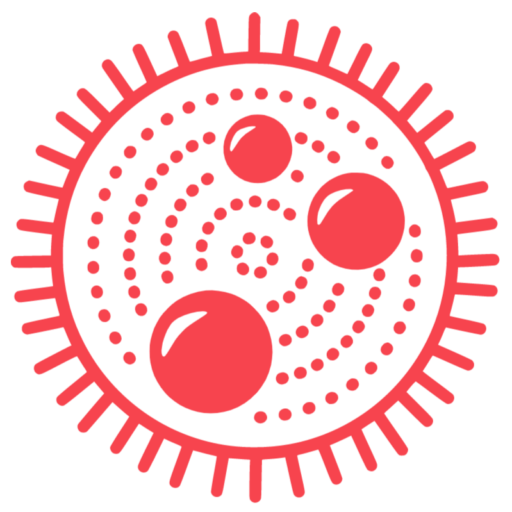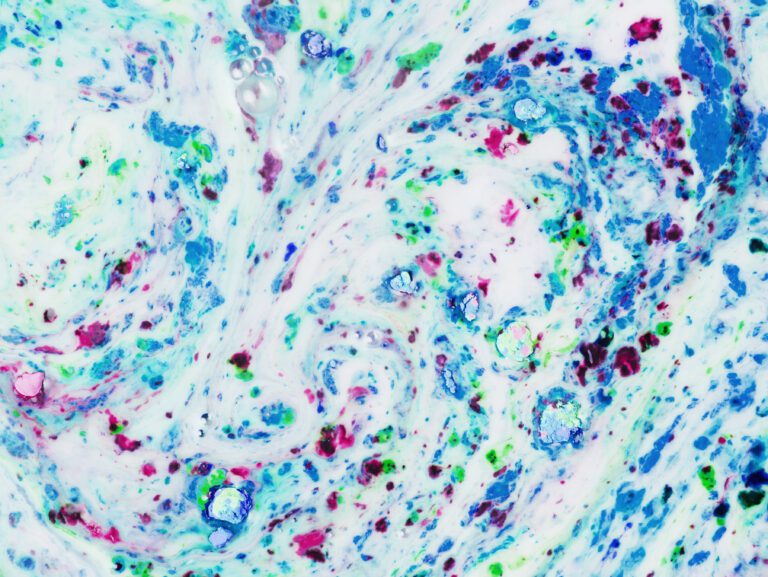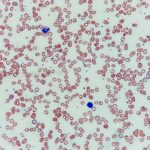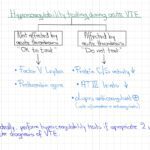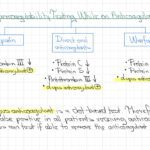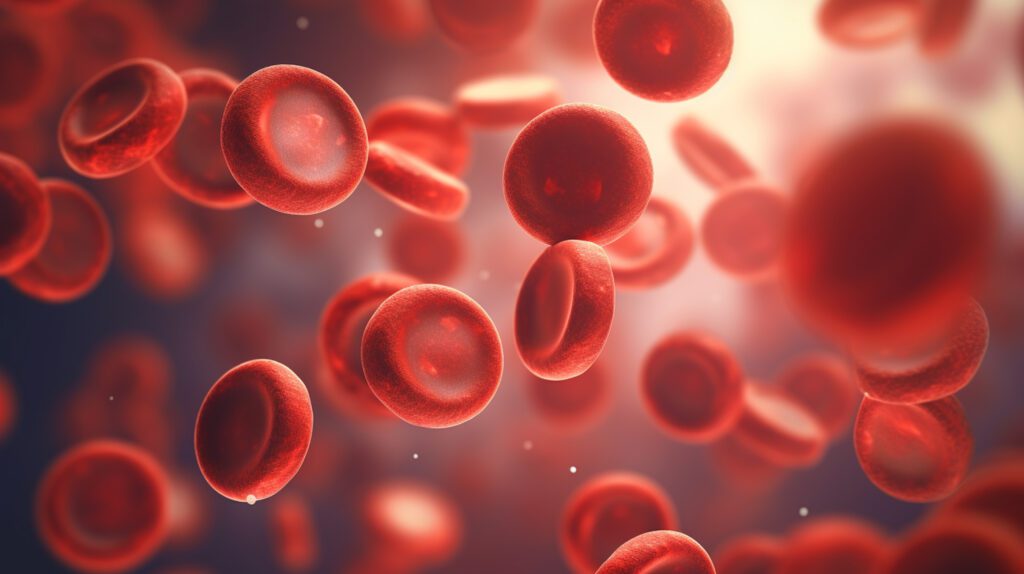
Red blood cells (RBCs), also known as erythrocytes, are the most common type of blood cell. The primary function of red blood cells is carrying oxygen from the lungs to the rest of the body and returning carbon dioxide from the body to the lungs to be exhaled. The normal function of red blood cells is vital for the body. For those of us who love red blood cells, this is one of the most broad and exciting topics in hematology. In this post, we will provide an overview of red blood cells and their disorders. In future posts, we will describe in detail the different red blood cell disorders, focusing on their diagnosis and management.
In this article, we will discuss:
Red Blood Cell Anatomy and Function
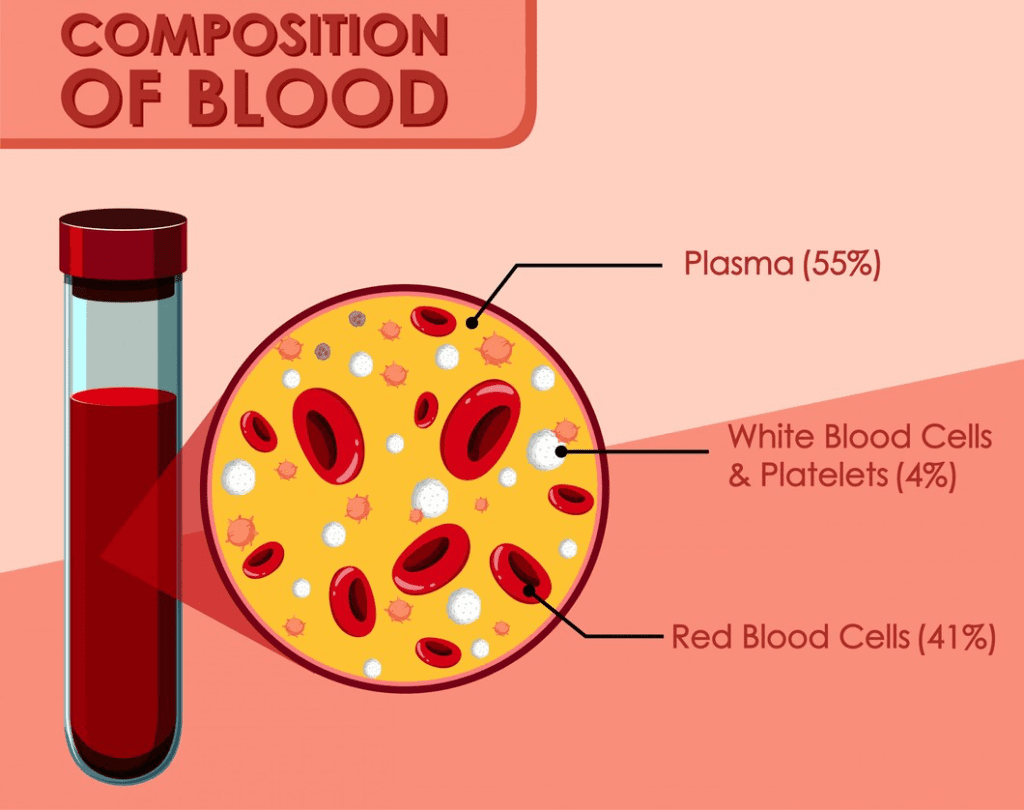
The human blood is composed of a fluid element termed “plasma” (55%) and blood cells constituting approximately 45% of the blood (41% red blood cells and 4% white blood cells and platelets). RBCs carry oxygen from the lung capillaries and deliver it to the body. The shape of the mature RBCs is biconcave, which increases their surface area for oxygen absorption and allows them to deform as they pass through narrow capillaries. Their biconcave shape gives them a central pallor which is characteristic of normal RBCs. They are about 7-8 micrometers in diameter. When reviewing a smear, the RBC size normally should be similar to the size of the nuclei of a small mature lymphocyte as seen in the picture below:
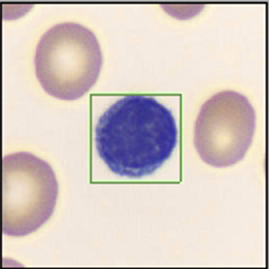
The color of RBCs is typically described as “red or pink.” The color of RBCs comes from hemoglobin (specifically from the heme component). Here is a table that summarizes the main characteristics of a normal red blood cell:
| Characteristic | Description |
|---|---|
| Shape | Biconcave and discoid |
| Size (Diameter) | 6 to 8 micrometers (µm) Can compare to the size of the nucleus of a small normal lymphocyte |
| Color | Pale pink to red |
| Central Pallor | Present, lighter area in the center |
| Uniformity | Minimal variation in size, shape, and color |
| Flexibility | High flexibility and deformability |
| Lifespan | Approximately 120 days |
Multiple RBC abnormalities could be observed in a peripheral smear and can point toward certain conditions. Here is a summary of the main RBC findings that could be detected by peripheral smear:
| Abnormality | Description | Associated Conditions |
|---|---|---|
| Anisocytosis | Variation in RBC size (when comparing one to another) | Nutritional anemias, hemolysis (due to larger erythrocytes) |
| Poikilocytosis | Variation in RBC shape (e.g., presence of spherocytes, schistocytes) | Hemolytic anemias, hereditary spherocytosis, thrombotic microangiopathies (TMA) |
| Hypochromia | Decreased hemoglobin concentration, resulting in increased central pallor | Iron deficiency anemia, thalassemia, sideroblastic anemia |
| Polychromasia | Increased central staining due to the presence of residual RNA | Reticulocytosis, hemolytic anemias, bone marrow recovery |
| Spherocytosis | Presence of spherical or hyperchromic RBCs | Hereditary spherocytosis, autoimmune hemolytic anemia |
| Elliptocytosis | Presence of elliptical or oval-shaped RBCs, indicative of membrane abnormalities | Hereditary elliptocytosis, hereditary ovalocytosis |
| Target Cells (Codocytes) | RBCs with a central area of hemoglobin surrounded by a ring of pallor | Liver disease, thalassemia, hemoglobinopathies |
| Stomatocytes | RBCs with a central slit or mouth-like appearance | Liver disease, hereditary stomatocytosis |
| Spur cells (Acanthocytes) | RBCs with irregularly spaced, blunt projections on the cell surface (spurs) | Abetalipoproteinemia, liver disease, abnormally high cholesterol levels |
| Burr Cells (Echinocytes) | RBCs with evenly spaced, short, blunt projections (wheel-shaped) | Uremia, liver disease, pyruvate kinase deficiency |
| Tear-drop Cells (Dacrocytes) | RBCs with a teardrop-shaped morphology, often seen in myelofibrosis or bone marrow infiltration (think of cells squeezing out of the marrow) | Myelofibrosis, myelodysplastic syndromes, leukemias |
| Rouleaux Formation | Abnormal stacking of RBCs, resembling a stack of coins, indicative of increased plasma proteins | Multiple myeloma, Waldenström macroglobulinemia |
| Agglutination | Clumping of RBCs due to the presence of immunoglobulins or complement proteins | Autoimmune hemolytic anemia, cold agglutinins, transfusion reaction |
| Schistocytes (fragmented or helmet cells) | Presence of fragmented or fragmented RBCs, indicative of mechanical damage (sliced RBCs) | Disseminated intravascular coagulation (DIC), thrombotic thrombocytopenic purpura (TTP), hemolytic uremic syndrome (HUS) |
| Heinz Bodies | Round or irregular inclusions within RBCs composed of denatured hemoglobin | G6PD deficiency, thalassemia, exposure to oxidizing agents |
| Howell-Jolly Bodies | Small, basophilic nuclear remnants within RBCs | Asplenia, functional hyposplenism, megaloblastic anemia |

Erythropoiesis

Erythropoiesis is the process by which new erythrocytes are produced. It occurs in the bone marrow and is stimulated by the hormone erythropoietin (EPO), which is produced by the kidneys in response to low oxygen levels in the blood. Erythropoiesis generates approximately 2 × 10¹¹ new erythrocytes to replace the 2 × 10¹¹ red cells (approximately 1 percent of the total red cell mass) removed from the circulation each day. As they mature, RBCs lose their nuclei and organelles. Reticulocytes are precursors of RBCs that still contain mitochondria and ribosomes (as well as RNA) which makes them “blue” when compared to the more mature RBCs that are “red.” Reticulocytes are round and they elongate and obtain their biconcave shape as they advance into a mature RBC.
Erythrocyte Turnover and Lifespan
The average lifespan of an RBC is about 120 days. After this period, they are removed from circulation by the spleen and liver. However, the lifespan of a red blood cell can decrease when there is increased destruction of the RBCs (hemolysis) which in response makes the bone marrow produce more red blood cells. The release of premature RBCs into the circulation is measured by the presence of reticulocytes. Hence, reticulocytes can serve as an indicator of bone marrow production. In our post “Laboratory Assessment in Hematology” we describe more in detail how the reticulocyte index can be used as a “bone marrow stress test.”
Hemoglobin Structure and Function
Hemoglobin is the most important molecule of the red blood cells allowing them to carry oxygen from the lungs into the tissues. Please, check the following video that describes the structure and function of hemoglobin:
Classification of Red Blood Cell Disorders
Anemias
Anemia is a condition characterized by a deficiency in the number or quality of red blood cells (RBCs) or hemoglobin, leading to reduced oxygen delivery to the body’s tissues. In most clinical situations, changes in red cell mass are secondary to hemoglobin concentration. In general, anemia occurs when the bone marrow cannot maintain normal blood counts in response to different situations (for example, when hemolysis is present, the bone marrow could compensate for RBC destruction by producing more erythroid precursors. Anemia may cause symptoms because of tissue hypoxia (e.g., fatigue, dyspnea on exertion). Some clinical manifestations can occur as compensatory mechanisms to ameliorate hypoxia (e.g., hyperventilation, tachycardia, and increased cardiac output) depending on the severity of the anemia.
There are many approaches to the classification of anemias. One of the most useful ways to classify anemias in clinical practice is to assess the degree of proliferation or response of the bone marrow to a decreased hemoglobin. The reticulocyte index or “bone marrow stress test” is a crucial component to determine if anemia is hypoproliferative or hyperproliferative. Hypoproliferative anemias occur mostly in nutritional deficiencies and bone marrow failure syndromes, while hyperproliferative anemias occur mostly in bleeding and hemolysis (as the bone marrow reacts to these insults). The reticulocyte index can be calculated manually or estimated by using an online tool such as MDCalc. Here is a summary of the formula and interpretation of the reticulocyte index:
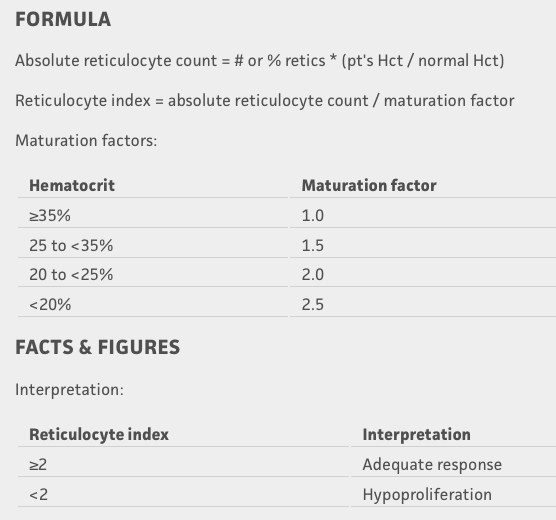
After calculating the reticulocyte index, anemias can be classified into hypoproliferative and hyperproliferative:
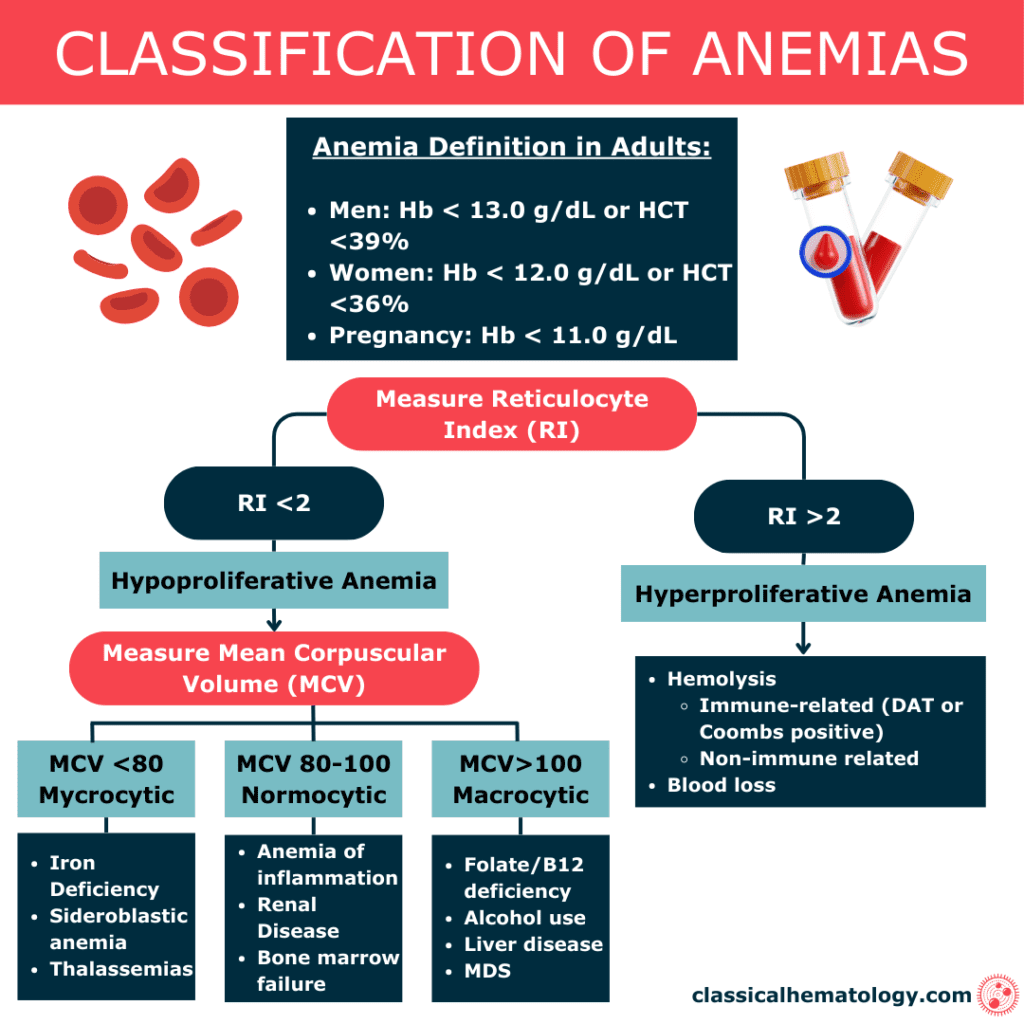
Polycythemias
The polycythemias are characterized by an increased RBC mass (erythrocytosis). They are best expressed in terms of the packed red cell volume (hematocrit), as their clinical manifestations are primarily related to the expanded red cell mass leading to increased viscosity of the blood. Polycythemias can be classified according to their cause into primary and secondary. Primary polycythemias are caused by somatic or germline mutations dysregulating the expansion of erythroid progenitors leading to exaggerated red cell production (i.e. clonal expansion such as in polycythemia vera). Secondary polycythemias are a result of increased levels of circulating erythropoiesis-stimulating factors, usually erythropoietin (EPO) due to tissue hypoxia (e.g., chronic pulmonary disease, high oxygen-affinity hemoglobin mutants).
Interestingly, some polycythemias have hypersensitive erythroid progenitors and increased levels of EPO-sharing features of both primary and secondary polycythemias. Examples of these “mixed” polycythemias include Chuvash polycythemia and some other congenital disorders of hypoxia sensing. Finally, relative (spurious) polycythemia can occur when there is an increased hematocrit as a result of a decreased plasma volume but a normal red cell mass (for example, dehydration).
In conclusion, red blood cells are crucial for the normal function of the body. Disorders of red blood cells can be classified into anemias and polycythemias. We will continue describing red blood cell disorders in future posts. Please, use our “curriculum” to guide you through the educational materials available.
We hope you enjoyed this post! Please, leave us any comments or questions below. Rate our post using the star system below if your time allows. Thank you for reading!
